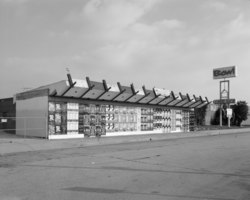History
After courts ruled segregation covenants to be unconstitutional, the area opened up to many different people. In the post-World War II era, a large Japanese American settlement ensued, which can still be found along Coliseum Street, east and west of Crenshaw Boulevard. [7]
African Americans started migrating to the district in the mid 1960s, and by the early 1970s later were the majority. [4] Due to a shared sense of discrimination, many Japanese-Americans had formed close relationships with the African-American community. [7]
There was an area Japanese school called Dai-Ichi Gakuen. [7] Around 1970, Dai-Ichi Gakuen had a peak of 700 students. [7] At that time, Crenshaw was one of the largest Japanese-American settlements in California, with about 8,000 residents. [7]
Beginning in the 1970s the Japanese American community began decreasing in size and Japanese-American businesses began leaving. Scott Shibuya Brown stated that "some say" the effect was a "belated response" to the 1965 Watts riots and that "several residents say a wave of anti-Japanese-American sentiment began cropping up in the area, prompting further departures." [7] Eighty-two-year-old Jimmy Jike was quoted in the Los Angeles Times in 1993, stating that it was mainly because the residents' children, after attending universities, moved away. [7]
In the 1970s, Crenshaw, Leimert Park and neighboring areas together had formed one of the largest African-American communities in the western United States.
By 1980, there were 4,000 Japanese ethnic residents, half of the previous size. [7] By 1990 there were 2,500 Japanese-Americans, mostly older residents. By 1993, the community was diminishing in size, with older Japanese Americans staying but with younger ones moving away. That year, Dai-Ichi Gakuen had only 15 students. In the 90s there began a shift to a new generation of Japanese Americans moving back into the neighborhood. [7]
Crenshaw had suffered significant damage from both the 1992 Los Angeles riots and the 1994 Northridge earthquake [8] but was able to rebound in the late 2000s with the help of redevelopment and gentrification. [9]
In 2018, the Baldwin Hills Crenshaw Plaza shopping mall had been approved for a major renovation plan, that would have included apartments, shops, and more restaurants. [10] The renovation was met with community opposition and did not happen. [11]
Geography
In 1996, the Los Angeles Times defined Crenshaw as "the area bounded by the Santa Monica Freeway on the north, Van Ness Avenue on the east, Slauson Avenue on the south and La Brea Avenue on the west. [12] In 2012, the Los Angeles Times reiterated that "the Santa Monica Freeway, completed in 1964, created an imposing barrier between the Crenshaw District" and neighborhoods to the north. [13]
The city has also installed a neighborhood sign at the intersection of Crenshaw Boulevard and Slauson Avenue. [14]
This page is based on this
Wikipedia article Text is available under the
CC BY-SA 4.0 license; additional terms may apply.
Images, videos and audio are available under their respective licenses.



